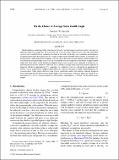On the Choice of Average Solar Zenith Angle
Author(s)
Cronin, Timothy W.
DownloadCronin-2014-On the choice of average.pdf (451.4Kb)
PUBLISHER_POLICY
Publisher Policy
Article is made available in accordance with the publisher's policy and may be subject to US copyright law. Please refer to the publisher's site for terms of use.
Terms of use
Metadata
Show full item recordAbstract
Idealized climate modeling studies often choose to neglect spatiotemporal variations in solar radiation, but doing so comes with an important decision about how to average solar radiation in space and time. Since both clear-sky and cloud albedo are increasing functions of the solar zenith angle, one can choose an absorption-weighted zenith angle that reproduces the spatial- or time-mean absorbed solar radiation. Calculations are performed for a pure scattering atmosphere and with a more detailed radiative transfer model and show that the absorption-weighted zenith angle is usually between the daytime-weighted and insolation-weighted zenith angles but much closer to the insolation-weighted zenith angle in most cases, especially if clouds are responsible for much of the shortwave reflection. Use of daytime-average zenith angle may lead to a high bias in planetary albedo of approximately 3%, equivalent to a deficit in shortwave absorption of approximately 10 W m[superscript −2] in the global energy budget (comparable to the radiative forcing of a roughly sixfold change in CO[subscript 2] concentration). Other studies that have used general circulation models with spatially constant insolation have underestimated the global-mean zenith angle, with a consequent low bias in planetary albedo of approximately 2%–6% or a surplus in shortwave absorption of approximately 7–20 W m[superscript −2] in the global energy budget.
Date issued
2014-08Department
Massachusetts Institute of Technology. Program in Atmospheres, Oceans, and Climate; Woods Hole Oceanographic InstitutionJournal
Journal of the Atmospheric Sciences
Publisher
American Meteorological Society
Citation
Cronin, Timothy W. “On the Choice of Average Solar Zenith Angle.” J. Atmos. Sci. 71, no. 8 (August 2014): 2994–3003. © 2014 American Meteorological Society
Version: Final published version
ISSN
0022-4928
1520-0469